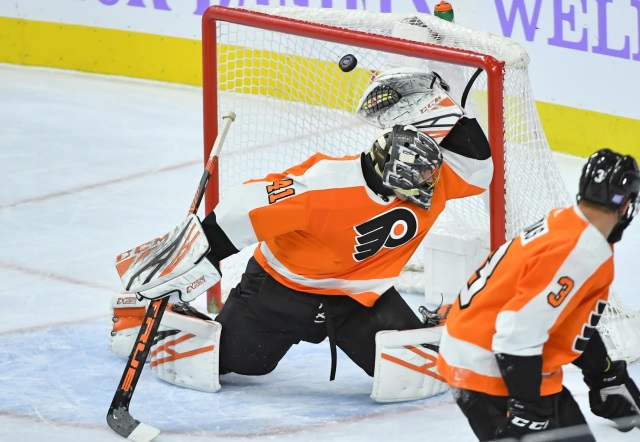Having fired Ron Hextall as general manager last week, the Philadelphia Flyers are currently in the process of finding a suitable replacement.
Former Minnesota Wild GM Chuck Fletcher is believed the front-runner. The Flyers have also reportedly spoken with Columbus Blue Jackets assistant GM Bill Zito and received permission to talk to Anaheim Ducks consultant (and former Toronto Maple Leafs GM) Dave Nonis.
Whoever replaces Hextall will be expected to act quickly to get the moribund Flyers back on a winning track. Entering the first full week of December 2018, they sit near the bottom of the Eastern Conference standings with 11 wins and 24 points in 25 games.
The priority should be finding a suitable starting goaltender. It’s an issue that’s bedeviled Flyers management stretching back to when Hextall last strapped on the pads in the late-1990s.
Of course, there are other areas the new Flyers GM must address. At times, the roster has appeared listless and lacking focus. They can’t score on the power-play (15.1 percent) and their penalty kill (71.3) is atrocious. They lack consistent production from their secondary scorers. Young defenseman Ivan Provorov looks like he’s regressed in his third NHL campaign.
Goaltending, however, remains the biggest problem. Without a reliable starter to provide stability between the pipes, the Flyers will continue to flounder.
The Flyers’ goals-against per game (as of Dec. 2, 2018) of 3.52 is fourth-worst among the 31 NHL clubs. That’s despite giving up the sixth-fewest shots-against per game (29.6). Little wonder, then, they’re sitting so low in the standings.
Since 1999 (stick tap to Hockey-Reference), the Flyers have employed 28 goaltenders. They’ve run the gamut from fading veterans (John Vanbiesbrouck, Jeff Hackett, Sean Burke) to failed prospects (Roman Cechmanek, Antero Niittymaki), to the injury-prone (Steve Mason, Brian Elliott, Michal Neuvirth), the offbeat (Ilya Bryzgalov) and the flash in the pan (Michael Leighton).
None of them adequately addressed the Flyers’ goaltending woes. The one netminder that could’ve addressed the issue, a young Sergei Bobrovsky, was passed over in favor of Bryzgalov and traded to Columbus, where he went on to become a two-time Vezina Trophy winner.
This season, the Flyers have employed five goalies: Neuvirth, Elliott, Calvin Pickard, Anthony Stolarz, and Alex Lyon. They’ve combined for a 3.32 goals-against average and .887 save percentage.
Fixing the problem, however, won’t be easy. Earlier this season, Hextall justified sticking with the oft-injured tandem of Elliott and Neuvirth by pointing out what few alternatives were available via trades and free agency.
In free agency, only Kari Lehtonen and Steve Mason remain and there’s no chance the Flyers will consider either guy.
As for the trade market, Bobrovsky topped TSN Frank Seravalli’s recent list of this season’s possible goaltender trade candidates. Pittsburgh’s Matt Murray, Detroit’s Jimmy Howard, Edmonton’s Cam Talbot, and Ottawa’s Craig Anderson were the others.
Bobrovsky is certainly the best option but it’s doubtful he’ll be available while the Blue Jackets are jockeying for first place in the Metropolitan Division. Should he test next summer’s unrestricted free agent market, there’s no certainty he’ll return to Philadelphia or that the Flyers will pay his rumored $10 million per season asking price.
Murray backstopped the Penguins to back-to-back Stanley Cups in 2016 and 2017 but he’s also frequently sidelined by injuries. Even if he was available, the Penguins won’t trade Murray to their arch rival.
Howard could become available if the rebuilding Red Wings are out of playoff contention by the February 25, 2019 trade deadline. For now, they’re unlikely to part with him while they’re within range of a playoff berth. At 34 years old, he would only be at best a short-term fix for the Flyers.
Talbot backstopped the Oilers into the playoffs for the first time in 11 years in 2016-17, but his stock has declined since then. While there’s some speculation over his future in Edmonton, he could prove a risky acquisition if he doesn’t snap out of his current funk.
The Senators currently lack depth within their system to replace Anderson so it’s unlikely they’ll shop him this season. He’ll turn 38 next May, making him (like Howard) a stopgap measure at best.
Addressing this issue will require bold action. Whether it’s opening the vault to bring back Bobrovsky next summer, or parting with some valuable assets for an established star, the next Flyers GM will face considerable pressure to address this long-standing need.



